
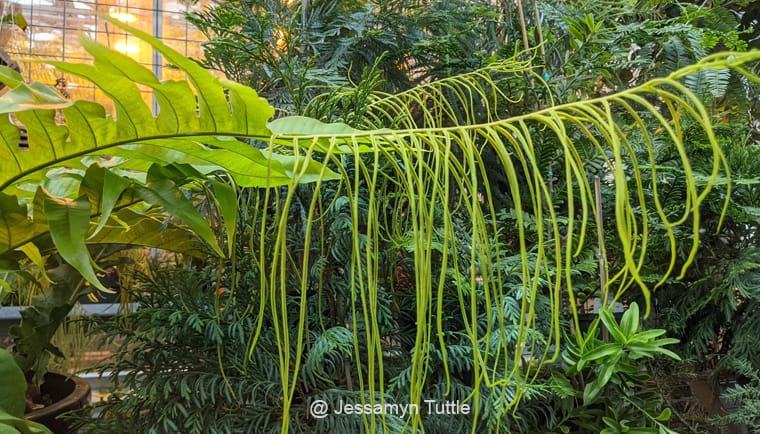
Master Gardeners Visit the UW Botanic Gardens
Hallmarks of the Master Gardener Program: Shared Love of Plants and Learning
Subscribe to the Blog >By Kay Torrance, Skagit County WSU Extension Master Gardener
What would draw a group predominately made up of WSU Cougs to venture into the heart of UW Huskies territory? It wasn’t a sporting event, but plants and a visit to the University of Washington’s extensive botanic resources: the Washington Park Arboretum, the Elisabeth C. Miller Library, and the new state-of-the-art UW Biology Greenhouse.
Regardless of the school colors they fly, a common characteristic among Master Gardeners is a shared love of plants and an ongoing commitment to learning. So it follows that when the opportunity to visit the extensive plant collections housed at the UW arose, it was not a surprise when registration filled quickly for the early March visit.
The tour’s first stop was the 230-acre UW Botanic Gardens Washington Park Arboretum. Noted for its meandering footpaths, the arboretum gardens feature collections of oaks, maples, camellias, and accompanying understory. During the early March visit the Joseph A. Witt Winter Garden was still in full splendor. The subtle colors of flowering hellebores and witch hazel were striking against a backdrop of textured bark from birches, maples, and twig dogwoods. Rhododendrons and camellias added a splash of dark green. The arboretum is open every day from dawn to dusk, free of charge.
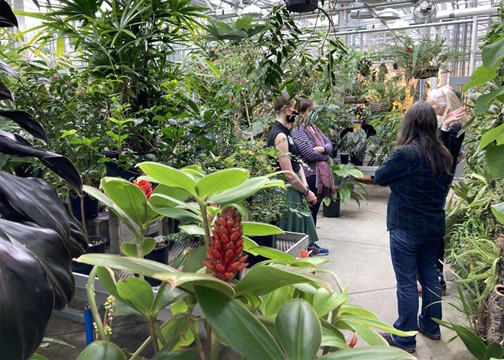
Photo: Bobbi Lemme
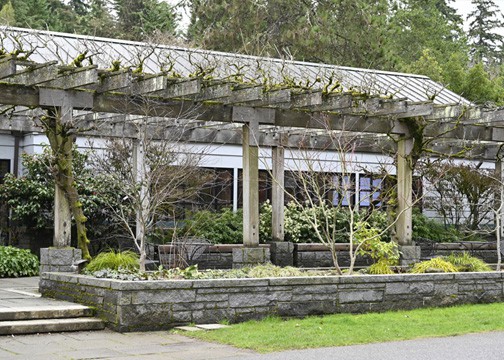
Photo: Kay Torrance
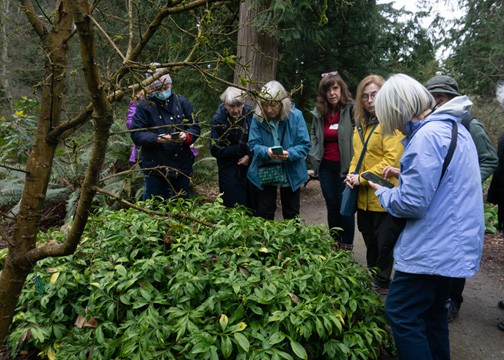
Photo: Jessimine Tuttle
Elisabeth C. Miller Library at the botanic gardens was the second stop on the trip. Here, Brian Thompson, Library Manager and Curator of Horticultural Literature guided the Master Gardener group through the library’s extensive resources.
The Elisabeth C. Miller Library features Pacific Northwest Connections, a collection dedicated to plants and gardening in our unique climate. The library also features collections focused on geographic areas from around the world including New Zealand, Australia, China, Japan, South Africa, Chile, and the Mediterranean. The library’s collection of over 16,000 books includes rare and historical books, botanical drawings, nursery catalogs, and over 200 current periodicals and back issues.
The walls of the Elisabeth C. Miller Library are devoted to rotating art exhibits. Outside of the library is a tranquil courtyard adorned with plants from all over the world and furnished with scattered chairs and tables, a perfect place to read and contemplate gardening. The library is open to the public six days a week.
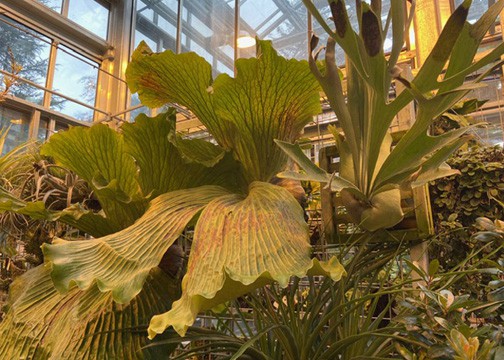
Photo: Diane Bowman
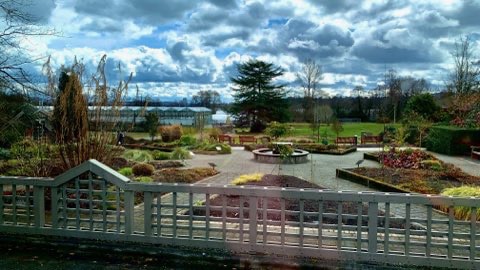
Photo: Charlene Day
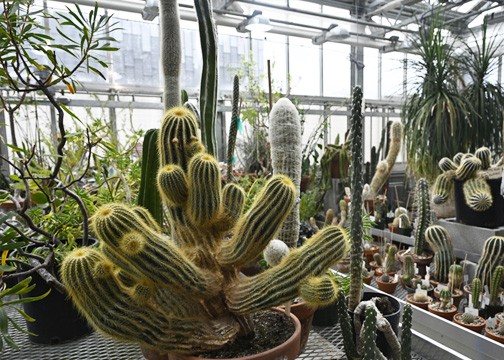
Photo: Kay Torrance
The final stop of the Master Gardener’s bus tour was the new UW Biology Greenhouse at the Life Sciences Building. The 20,000-square-foot greenhouse first opened to the public in 2022. The state-of-the-art building is home to over 4,000 species of plants and growing! Master Gardeners were guided through four-themed garden rooms: Warm Tropics, Tree of Life, Cool Tropics, and Desert. On the cool, early March day, it was wonderful to take our coats off and step into a desert and then into a jungle.
Seattle botanical artist Crystal Shin was our docent for the Desert Room where plants are grouped by continent of origin. As the primary botanical illustrator for the University of Washington Herbarium book Flora of the Pacific Northwest (2nd Ed.) Crystal has spent extensive time studying and illustrating plants in the UW collection. The Desert Room holds an impressive collection of North American cacti and a table of euphorbias from Africa. Prized specimens include a Welwitschia from Namibia, and a cherry blossom pink Adenium, and examples of Gasteria. Many of the plants demonstrate convergent evolution where plants adaptation mechanisms resulted in similar appearance despite separate evolutionary lineages.
Alex Lowe, a graduate student advisor, led the Master Gardeners through the Tree of Life room where plants are displayed in their evolutionary order of appearance starting with algae and mosses and then moving through Selaginellas, lycopods, ferns, gymnosperms, and finally angiosperms. The room includes examples of plants with economic importance such as bananas, pineapples, peppers, vanilla orchids, tobacco, and cotton.
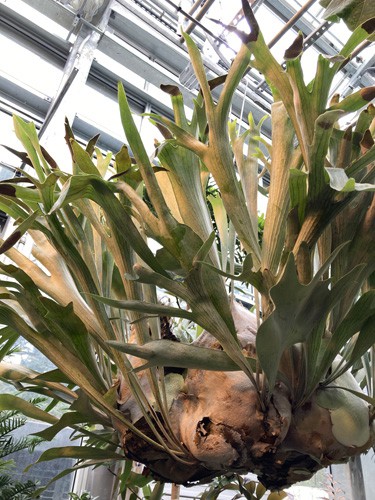
Photo: Kay Torrance
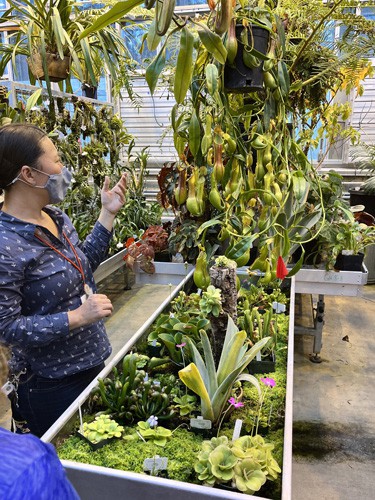
Photo: Kelly Maupin
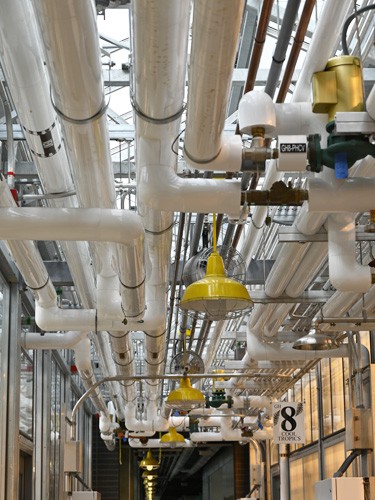
Photo: Kay Torrance
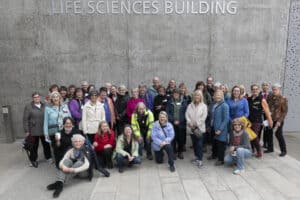
A large group of Skagit Master Gardeners received continuing education credits for tour and learning experience to the University of Washington Botanic Gardens. Photo: Nancy Crowell
Next, we walked into the lush Warm Tropics room with Hannah McConnell, Ph.D. candidate, and were surrounded by palms, gingers, water plants, and orchids including a huge Grammatophyllum specimen.
The final garden room was the Cool Tropics Room. Here, Nile Kurashige, greenhouse plant technician introduced the group to tropical plants native to higher altitudes or latitudes. Highlights of the room included more orchids, carnivorous plants, Hoyas, and a huge Angiopteris fern reaching toward the ceiling.
In addition to the four garden rooms, the greenhouse complex has five climate-controlled rooms for education and research purposes and classroom space for courses in plant biology. The Biology Greenhouse supports UW students in subjects ranging from plant ecology to landscape architecture and anthropology. The greenhouse is open to the public for browsing on non-holiday Thursdays, and on the 2nd and 4th Saturdays of each month from 12 – 4 pm.
As the final tour wrapped up and we boarded our bus to head home, we were grateful for the learning opportunity, and realized how fortunate we are to have these world-class botanical resources open to the public and so close to home.
REFERENCES:
More info can be found at:
https://www.biology.washington.edu/facilities/greenhouse
Instagram at https://www.instagram.com/uwbiogreenhouse/.
https://www.seattletimes.com/seattle-news/inside-uws-new-greenhouse-and-a-closeup-look-at-its-rare-and-exotic-plants/
New home gives biology department’s plant collection room to grow
Leo Hitchcock and Arthur Cronquist Ed. 2018. Flora of the Pacific Northwest. 2nd Ed. Seattle, WA, University of Washington Press
ABOUT THE AUTHOR:
Kay Torrance is a Skagit County WSU Extension Master Gardener. She is Coordinator of the Naturescape Garden at the Discovery Garden on State Route 536 west of Mount Vernon.
Questions about home gardening or becoming a Master Gardener, may be directed to: Skagit County WSU Extension Office, 11768 Westar Lane, Suite A, Burlington, WA 98233; by phone: 360-428-4270; or via the website: www.skagit.wsu.edu/mg